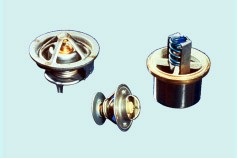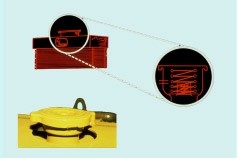
The cooling of an engine depends on the principles of conduction, convection, and radiation of heat energy in order to keep the engine running at the proper operating temperature. The coolant receives the heat that is conducted to it from the metal components of the engine; the engine block, the cylinder head, etc. The coolant is then forced by the water pump from the engine to the radiator. At the radiator the heat energy is transferred by convection to the air moving across the fins of the radiator. In addition the engine also radiates a certain amount of energy to the atmosphere directly in the form of heat that is given off from the engine to the surrounding air.
The components of a cooling system for an engine are extremely simplistic. The basic components of every cooling system include:
- The water jacket
- The water temperature regulator(s) (thermostat(s))
- The radiator (or heat exchanger)
- The pressure cap
- The water pump
- Hoses
The engine may also have some type of coolant cooled aftercooler, oil cooler, hydraulic cooler, or transmission cooler.
Some marine or stationary systems may have a heat exchanger in place of the radiator.
The pump is what causes the coolant to flow in the cooling system. Inside the engine are coolant passages that the water flows in. These passages include what is sometimes called a “water jacket.” The water jacket is the large cavity in the block and the head that surrounds the cylinders of the engine. This cavity is normally full of coolant and is what keeps the engine at a uniform temperature.

The water temperature regulator(s) (thermostat(s)) regulate the flow of coolant to the radiator. When the engine is cold, the water temperature regulator is closed and the water coming from the engine is closed off from the radiator. The water is then recirculated through the water pump, back into the engine. This helps the engine acheive operating temperature more quickly. When the engine is warm, the water temperature regulator allows the coolant to flow to the radiator to be cooled before reentering the engine. The water temperature regulator is not strictly fully open or fully closed. The water temperature regulator modulates between open and closed in order to keep a constant temperature in the engine. Proper engine temperature is very important. An engine that runs too cold will not operate at a high enough temperature to have efficient combustion and will lead to sludge buildup in the lubrication system of the engine. An engine that runs too hot will overheat and may lead to serious damage of the engine.

The radiator is the component of the cooling system that rejects the heat from the coolant to the air. A radiator has tubes that the coolant flows through most generally from the top of the radiator to the bottom. At the bottom of the radiator there is a hose leading to the pump to start the circulation over again. The tubes have fins attached to them that help to reject the heat to the air moving across the radiator.

Perhaps the most overlooked component of the cooling system is the pressure cap. The pressure cap has a relief valve that will not allow the pressure of the cooling system to exceed a predetermined level. The pressure cap maintains a certain amount of pressure in the cooling system. This is very important because, by increasing the pressure of the cooling system by 1 psi, the boiling point of the coolant is raised 3.25 degrees F. This allows coolant to run hotter wihout boiling. A typical cooling system will have anywhere from a 7 psi to a 12 psi pressure cap, so this can have a significant effect on the cooling of an engine.